Zeroing In on Net-Zero Energy
With an office building for its Colorado campus, a national research lab aims to prove that super-green can be cost effective and replicable.
![]() Continuing Education
Continuing Education
Use the following learning objectives to focus your study while reading this month’s Continuing Education article.
Learning Objectives - After reading this article, you will be able to:
- Define net-zero energy.
- Discuss the strategies the RSF project team deployed to achieve an ultra-low-energy building.
- Explain the procurement process used to design and build the RSF.
- Describe the challenges encountered by the RSF design and construction team.
Given its mission of developing renewable energy and energy-efficient technologies, it isn't so surprising that the National Renewable Energy Laboratory (NREL), in Golden, Colorado, would want an ultra-high-performance building for the more than 800 staff members it planned to move from leased office space to its research campus at the base of South Table Mountain. The building, the 220,000-square-foot Research Support Facility, or RSF, which opened in June, is designed to be just that. If it performs as intended, the RSF will consume only 35 kBtu per square foot annually, even taking into account the power requirements for a data center that serves all 2,200 NREL employees. This energy use intensity (a measurement of the amount of energy consumed by a building relative to its size) is about 50 percent less than that for one that complies with the 2004 version of the ASHRAE 90.1 standard. If it operates as expected, the facility should also qualify as the largest net-zero energy building in the U.S.
The RSF isn't only about ambitious energy-efficiency goals, however. NREL, which is part of the U.S. Department of Energy (DOE), hoped that the project would demonstrate that large-scale super-green buildings could be both cost effective and commercially viable. With a construction cost of $57.4 million, or $259 a square foot, the RSF's budget is in line with other recently completed office buildings in nearby Denver. "It isn't just a cool building. It is a new class of real estate," says Philip Macey, AIA, director of engineering and sustainability for Haselden Construction, one half of the RSF design-build team.
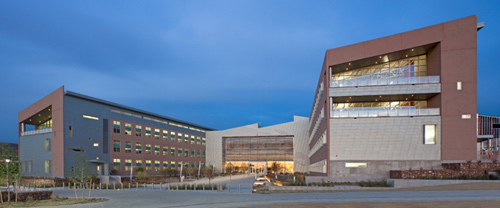 |
The RSF has a skewed-H-shaped plan defining exterior courtyards. The building's two wings are elongated on the east-west axis to make the most of sunlight for interior illumination. Photo: © Frank Ooms |
 |
1 Research Support Facility Diagram: Courtesy RNL |
Net zero defined
What is a net-zero building? At the most fundamental level, it is a building that annually generates enough energy on site from renewable sources to equal or exceed demand. Like the NREL facility, most zero-energy buildings are grid-connected, drawing power from, and supplying it to, a local utility. In the case of the RSF, a 450 kW roof-mounted photovoltaic (PV) array, supplied through a power purchase agreement with solar energy provider SunEdison, serves as the renewable source.
 |
||
Diagram: © VStudios |
Curiously, a net-zero building was not one of the highest-priority elements of the RSF program. A request for proposals released in late 2007 ranked the client's needs into "mission critical," "highly desirable," and "if possible" project goals. The document, part of a procurement process the DOE has dubbed "performance-based design-build," listed the highest level of LEED certification among the top priorities (the RSF is on track for a Platinum rating), but put net zero with those objectives under the "if possible" heading.
By establishing this hierarchy and deviating from the DOE's traditional design-bid-build delivery method, the owners hoped to encourage teams competing for the project to come up with the optimal design solution within tight schedule and budget constraints. The goal was not to build the least expensive building. "The budget was fixed, so there was no incentive to build the RSF for less," explains Paul Torcellini, NREL group manager for commercial buildings research. "Instead we wanted to achieve the best value with the money we had available," he says.
The design-build team eventually selected for the project - architecture and planning firm RNL and Haselden Construction - aimed to satisfy all of the owner's ambitions, even the items on the wish list. "We decided that if we didn't give the clients everything they wanted, we wouldn't win," says Craig Randock, AIA, RNL principal. Of the three short-listed teams invited to submit a detailed conceptual design, the RNL-Haselden group was the only one that offered a net-zero building in its proposal.
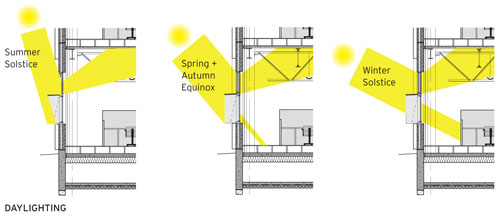 |
The geometry of the windows and shading devices on the RSF's south-facing windows limits heat gain and glare while allowing for effective daylighting. The windows include operable lower vision panels that aid natural ventilation and night flushing. Fixed upper panels have integrated louvers that reflect light toward the ceiling. Light shelves shade the vision panels and direct sunlight through the louvers. Diagram: Courtesy RNL |
Risks and rewards
Pursuing the RSF project was in many ways a tremendous gamble for RNL and Haselden, says RNL president Richard von Luhrte, FAIA, who estimates that the team spent $1.2 million on its competition proposal. After its selection, if the design-builder had not been able to satisfactorily demonstrate that the proposed building was feasible within the allotted $64 million project cost, it would have forfeited 50 percent of its design fee. But there were also potential rewards, including an incentive of up to $2 million for meeting budget, schedule, and energy performance goals. (To date, the team has earned 97 percent of these funds.)
This financial carrot wasn't the only enticement for taking on the RSF, according to von Luhrte. "We were committed to the project goals, the mission of the lab, and had a long history of working on its campus," he says. The firm's previous projects include a headquarters designed in the late 1970s, but never built, for NREL's predecessor organization, the Solar Energy Research Institute.
For John Andary, a principal in the San Francisco office of Stantec, which the design-build team chose as its mechanical engineer, the NREL job provided an opportunity to employ concepts it had long been developing on a much smaller scale. Andary's largest net-zero project prior to the RSF was several buildings for the campus of a San Francisco Bay Area private school designed with EHDD Architecture and totaling 40,000 square feet.
 |
The building's south facade incorporates an NREL-developed device called a "transpired solar collector" and an aggressive window shading system. Photo: © Frank Ooms |
Synergies and strategies
Bringing the aggressive performance goals within reach would require a scheme that lowered energy use with little or no addition to first costs. So even before meeting the rest of the team, Andary began working on the project, performing modeling and simulations. These studies produced an initial concept that included a narrow floor plate to assist daylighting and natural ventilation, a radiant system for heating and cooling, and plenty of building mass to help moderate indoor temperatures.
"We came to the first face-to-face meeting prepared to offer solutions," he says.
The design-build team quickly understood that no one move would make reaching net zero possible. The building would need to rely on a host of tightly coordinated strategies, each offering an incremental benefit, "but when combined, they create synergies," explains Macey, who recently joined Haselden from RNL, where he served as manager of the RSF project.
The scheme ultimately realized has a steel frame and a plan that resembles an out-of-kilter H, with a 454-foot-long, four-story wing to the north and a 364-foot-long, three-story wing to the south, connected to define a pair of courtyards. The wings, devoted primarily to open office space, are each 60 feet wide. This depth, along with a system of light shelves and louvers, facilitates penetration of daylight, allowing employees to work with little electric illumination for much of the day.
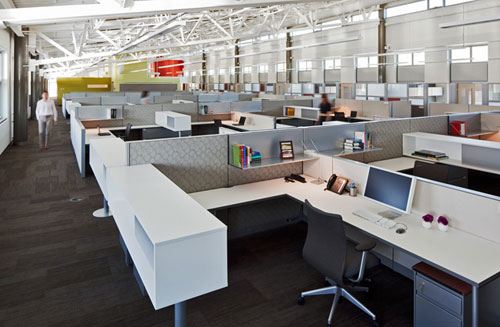 |
Within the RSF's open office wings, columns made from salvaged natural-gas piping, and the trusses spanning them, have been left exposed. Photo: © Frank Ooms |
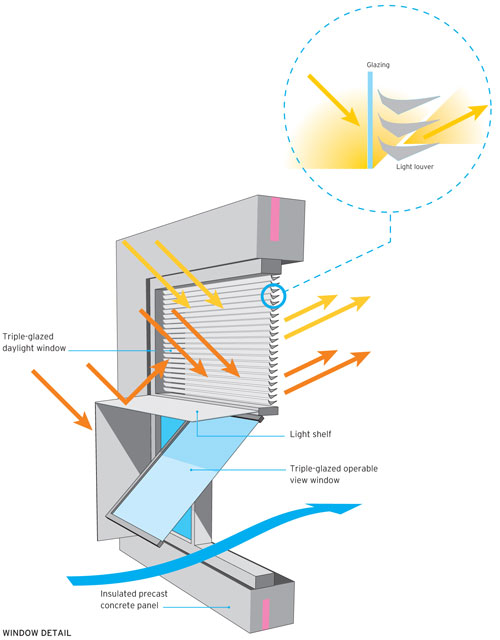 |
Diagram: Courtesy RNL |
In addition to reducing the energy consumed by lighting fixtures, this tactic produced a number of additional benefits, including a corresponding reduction in the heat rejected from the lighting, which in turn lessened cooling loads and the portion of the budget that would need to be allocated to mechanical systems and the PV array.
One consequence of the building's configuration, with its elongated, daylight-oriented wings, was more exterior envelope than would have been required by a scheme enclosing the same volume but with deeper floor plates. As a result, the skin was an important focus of the project team's efforts. Designers developed an assembly of insulated precast concrete panels with the required thermal properties. These components had the added benefit of helping speed construction because of their off-site fabrication. Windows, which are triple-glazed, make up only about 25 percent of the long north and south facades. On the much smaller east and west elevations, electrochromic and thermochromic glass, or so-called switchable glazing, helps control heat gain and glare.
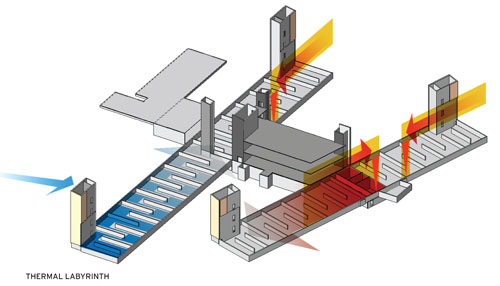 |
Below the RSF's footprint is a crawl space containing staggered poured-in-place concrete walls. This "thermal labyrinth" stores heat from air warmed by the transpired solar collectors and heat rejected from the data center. The stored thermal energy is used to preheat ventilation air during the winter. Cool air can be drawn into the crawl space through corner towers to purge heat from the concrete mass. Diagram: Courtesy RNL |
The building envelope also incorporates NREL-developed technology - devices called "transpired solar collectors" that consist of perforated corrugated metal mounted on the south facades. These rely on the sun to passively preheat outside air trapped in the cavity between the collectors and the precast panels making up the weatherproof enclosure. The air is then drawn into a crawl space underneath the building. In the winter, the heat from this outside air, along with waste heat from the data center, is stored in the staggered poured-in-place concrete walls making up this "thermal labyrinth." This stored thermal energy is subsequently used to preheat ventilation air delivered to the offices through a raised floor system. In the summer, cool night air flushes the labyrinth and the RSF's occupied spaces. The inertia of the exterior walls, which are left exposed without a drywall interior finish, along with the radiant piping embedded in the ceiling slabs, helps maintain the occupants' thermal comfort throughout the course of the day.
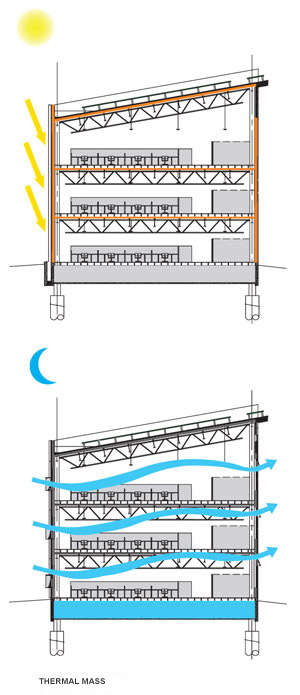 |
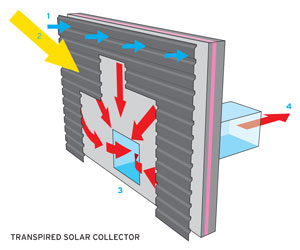 |
ABOVE:
LEFT: The building's precast concrete cladding is exposed on the interior, providing thermal mass. The walls store excess heat over the course of a summer day, reducing the cooling load. When nighttime interior temperatures exceed 70 degrees, operable windows automatically open, allowing the thermal mass to cool.
Diagrams: Courtesy RNL |
Round two
Many of these same techniques are being deployed in a 138,000-square-foot expansion of the RSF already under way with the same design-build team. But some of the elements have been subtly tweaked. For example, new details for the precast cladding panels allow more continuous insulation, windows and curtain walls incorporate improved thermal breaks, and the mechanical system includes a more efficient heat-recovery device. According to RNL and Haselden, these and other modifications should make the second phase of construction even more economical than the first. They should also improve energy efficiency: The newer portion of the RSF is expected to have an energy-use intensity of less than 29 kBtus per square foot each year.
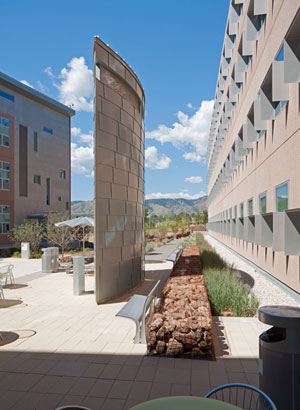 |
The RSF's bid for LEED Platinum includes site strategies such as permeable pavement in courtyards and gabion walls made from rock recovered during excavation for the foundations. Photo: © Frank Ooms |
The performance expectations for both phases of construction are based on exquisitely detailed energy simulations. The studies even take into account RSF features difficult to model with off-the-shelf software, including the radiant slabs, the transpired solar collectors, and the labyrinth. To predict the contribution of these elements to the building's performance, Stantec engineers devised work-arounds that relied on elaborate spreadsheet calculations unique to the project. The result was a model comprehensive enough to convince NREL that the design-build team would be delivering a building matching its proposal.
As a savvy client, NREL recognized that the RSF's success would not entirely be a function of the building's engineering and architecture. Achievement of the ambitious energy conservation targets would also depend on how occupants inhabited the space. So even before issuing its request for proposals, the owner conducted a thorough survey of plug loads (devices that plug into the building's electrical system) in its existing office spaces, including workstation computers, task lights, and refrigerators in break rooms.
It also benchmarked process loads, such as elevators and control systems, and then created stringent guidelines for new equipment. "In many ways we already know how to get the architecture and engineering right," says Andary. "We need to focus more attention on the stuff that plugs into the wall."
The completed first phase of the RSF is now almost entirely occupied and undergoing a measurement and verification process, ending in July, that involves monitoring the building's energy consumption. The design-build team is looking forward to these results, as the last bit of its incentive payment is tied to them. But the team members' keen interest is more than a by-product of the remaining award funds. "As a responsible partner," insists Macey, "we want to know how the building is working."
